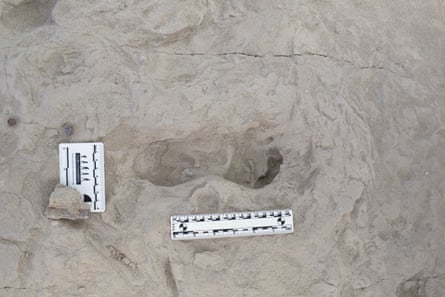About 1.5m years ago a big-toothed cousin of prehistoric humans walked quickly along a lakeside in Kenya, footprints marking the muddy ground. But they were not our only ancestor on the scene: treading the same ground was the early human Homo erectus.
Researchers say an analysis of fossilised footprints discovered in deposits of the Turkana Basin, northern Kenya, suggest the marks were made by two different species on the human family tree who were in the same place within hours or days of each other.
While skeletal fossils have previously suggested these species may have coexisted, the timespans they can be dated to, and the size of the deposits they are found in, are too large to pin down interactions.
“This is the first direct snapshot of the two species together on the same immediate landscape,” said Dr Kevin Hatala, the first author of the research from Chatham University in the US.
Writing in the journal Science, Hatala and colleagues reported how, along with fossilised tracks from birds and other animals, they discovered a continual set of footprints in the deposits made by a single hominin individual.
The stride length of the trackway, they noted, suggested that individual was walking at a modestly fast pace. However, the impressions differed from those observed in modern humans, in terms of foot anatomy and the patterns of contact made by walking.
Instead, they said, the impressions appeared to fit with footprints expected from Paranthropus boisei, a species also known as Nutcracker Man in reference to its big teeth, which is not a human ancestor but sits on a side branch of our family tree.
“There are aspects of their big toe anatomy, in particular, that seem consistent with the patterns that we see in the footprints,” said Hatala.
The team also found three separate prints close by that were in different orientations to this trackway.

These, the researchers said, did appear similar to those observed in modern humans, suggesting they were made by Homo erectus, an ancestor of our own species that lived in the region at the time.
“I would expect the two species would have been aware of each other’s existence on that landscape, and they probably would have recognised each other as being ‘different’,” said Hatala. “This raises lots of fascinating questions about how they would have interacted, and we don’t have all of those answers yet.”
The researchers added that when they looked back at other examples of fossilised hominin footprints found in east Turkana from a similar time period, they realised some also showed signs of having been made by two different hominin species.
Prof Chris Stringer, the head of human origins at the Natural History Museum in London and who was not involved in the work, described the research as fascinating, noting that while it was impossible to be completely sure which species made the tracks, the team had been careful in assessing the probabilities.
“It’s wonderful that these early human relatives can now be placed directly in a lakeside landscape, walking and wading on wet surfaces, and probably feeding on the plant and animal resources there,” he said. “[The authors] suggest that the two species with their different diets were probably not competing strongly at this time, hence their close and tolerant proximity in time and space.”

 2 months ago
54
2 months ago
54













































